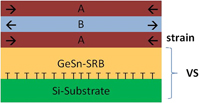Article contents
Group IV heteroepitaxy on silicon for photonics
Published online by Cambridge University Press: 22 November 2016
Abstract

Silicon emerged as an important substrate material for photonics because of its transparency in the near infrared and its superior planar waveguide properties. Active optoelectronic devices in the infrared wave length regime need semiconductor heterostructures with smaller band gaps as silicon, preferably from the group IV material system. This paper describes fundamental properties of lattice mismatched group IV heterostructures on silicon and their synthesis with epitaxy methods. Special emphasis is given to the aspects of strain management in lattice mismatched device structures and to the realization of metastable non-equilibrium materials. Well-defined strain status is obtained by growth on virtual substrates which consist of silicon substrates with strain relaxed silicon germanium buffer layers. Epitaxy methods at low growth temperatures pushed the synthesis of germanium tin alloys with tin concentrations more than ten times the equilibrium value of about 1%. These achievements pave the way for silicon photonics to efficient light emission and mid infrared operation.
Keywords
- Type
- Invited Feature Paper
- Information
- Copyright
- Copyright © Materials Research Society 2016
References
REFERENCES
- 7
- Cited by



